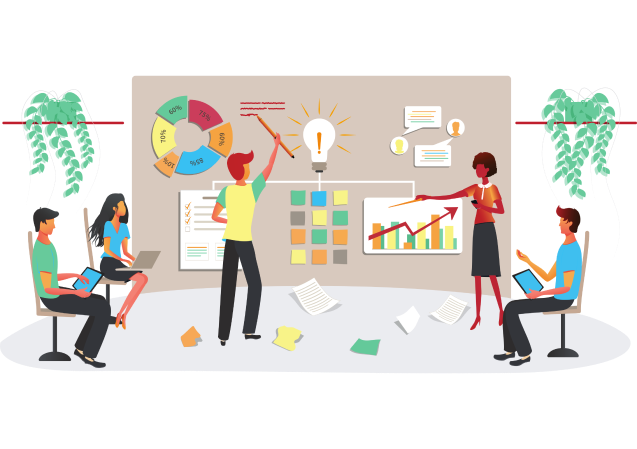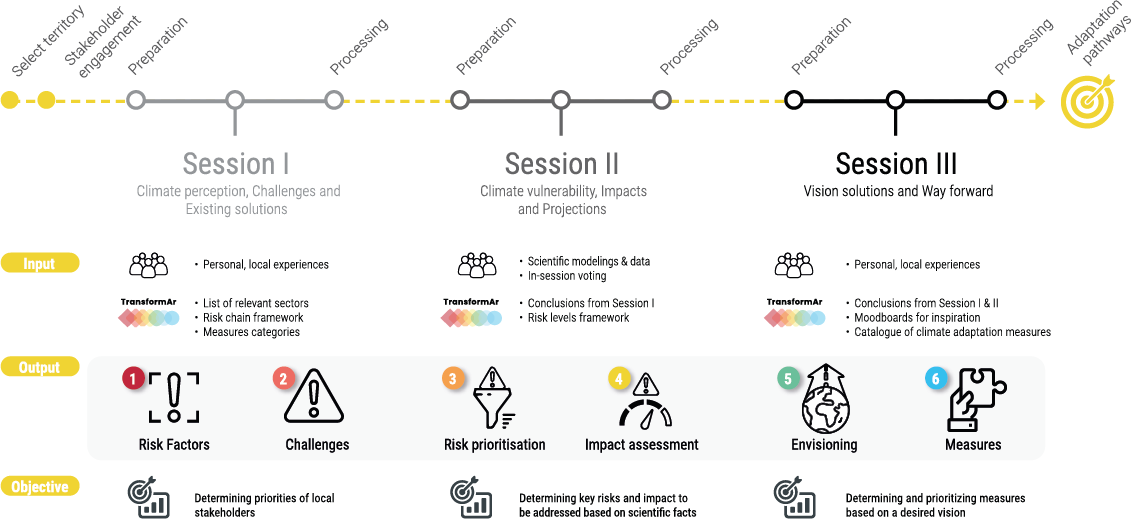
How to create a climate adaptation workshop?
The TransformAr workshop methodology:
The TransformAr workshop methodology consists out of 3 sessions:
Session 1: Climate perception, challenges and existing solutions
Session 2: Climate vulnerability, impacts and projections
Session 3: Vision solutions and way forward
The overall objective of these three sessions is to co-construct adaptation pathways, made up of a sequence of decision points and measures allowing for decision making in a specific region.

During these sessions you will follow 6 steps:
- Identify the climate-related risks faced by a given sector. Develop Risk Chain with climate hazards, exposure, vulnerability, intermediate impact risk & Socio-economic impacts
- Select the most prominent risk (which you would like to address by developing adaptation pathways). Identify key issues to be addressed, to be determined by the participants themselves through discussions, activities, or other.
- Determine risk levels and outcomes (low, medium, high, very high risks). This is to be determined by participants through a discussion with scientists. E.g., what does it mean to have a low risk of [a specific risk] (e.g., soil erosion / surge of infectious diseases/ etc.)? What is the outcome?
- Choose (a) relevant indicator(s) to measure/monitor the risk: This is to be able to assess and monitor the risk evolution. To be able to determine a relevant indicator, it is important to determine risk outcomes (e.g., if soil erosion has impacts on crop productivity, the latter could be a good indicator. Productivity can be assessed in weight of produced crop (Tons), Money equivalent (€), etc.)
- Identify critical thresholds (at which point do we go from one risk level to another) E.g., a reduction of 5% of crop productivity means the passage from low-risk level to medium risk level, a 10% reduction of crop productivity means an intensification of risk going from medium to high, etc.
- Set one or several objective(s) (Develop a vision). E.g., a reduction of 5% of crop productivity means the passage from low-risk level to medium risk level, a 10% reduction of crop productivity means an intensification of risk going from medium to high, etc.
- Identify relevant solutions (adaptation measures) that align with the objective/ vision. Classification of good/vs. bad solutions.
- Assess the relevance of each option and prioritize them based on risk levels and alignment with the set objective. Classification of solutions based on determined risk levels
Should you organize your workshop online or offline?
Some workshops are better held online and some offline.
Some advantages of online workshops are:
- It might be easier to bring different stakeholders together as they can join the workshop from their home/workplace
- No additional supplies like post-its and pens needed
- It might be easier to schedule this as the participants don’t need to go to a specific location. This will especially be the case if you do the 3 different sessions on 3 separate moments (what we would recommend to do in order to have time to fill in the conclusion canvases)
Some advantages of offline workshops:
- You won't experience the issues with a bad internet connection
- Some people are more engaged to participate if it is in person
- It is easier to interact with the participants (one to one and the participants between themselves)
You have to estimate which one would fit best with your stakeholders. In this webtool you can easily set up an online workshop with the premade canvases. If you decide to organise an offline meeting, you can download the canvases on the page for the offline workshop and fill in the conclusion canvases in this webtool.
What will be the outcome of the workshops?
After each session you’ll have to fill in a conclusion canvas. This will help you in the next session. The conclusion canvas for the third session will help you create the adaptation pathways.
The final outcome of the TransformAr workshops will be the adaptation pathways specific for your climate problems in your region and for your stakeholders. You will create different possible pathways and select the most important one based on feasibility.
